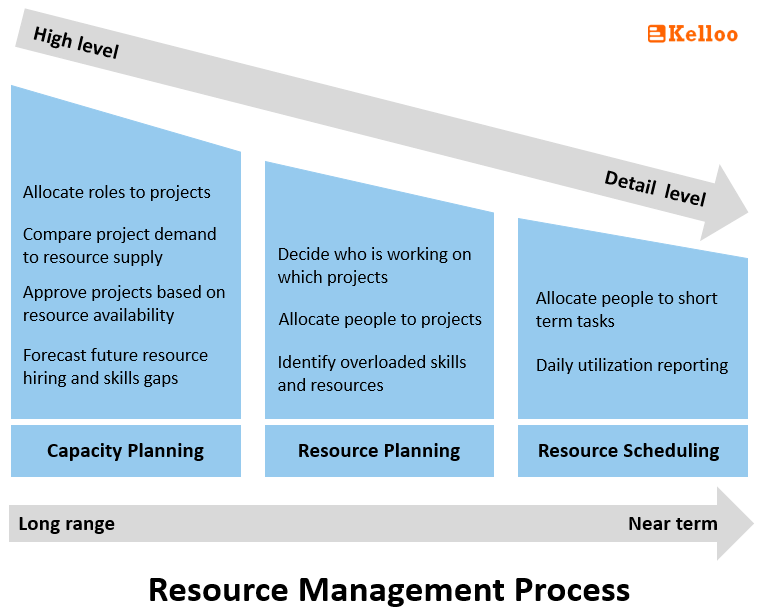资源日历--用一个工具管理整个团队
资源日历(或项目管理日历、或项目规划日历、资源规划软件)可让您更有效、更高效地规划、管理和分配资源--尤其是如果 Microsoft Excel 在您的项目中发挥了主导作用。
项目经理的终极目标是什么?成功交付项目。项目经理自己也承认,这种情况并不常见:根据最新的 "专业脉搏 "调查,按时或在原预算范围内完成的项目不到 601TP3。
您将从这篇文章中获得什么?
有效管理资源能力可以帮助公司提高这些数字。在本文中,您将了解到更多关于项目管理中资源容量规划的信息,同时我们也将介绍公司级容量管理的优势。让我们从一些必要的定义开始。

基于技能的搜索和人员任务分配[资源规划软件屏幕]...
无需赘言,能力指的是实现、执行或生产的能力。如果我们从公司的角度来看,它指的是在特定时间内实现或生产的能力。但是,如果我们深入挖掘,从运营的角度出发,我们就会发现,能力被理解为在一段时间内产生相对产出的可投入资源的数量--我们可以在 managementstudyguide.com 上阅读。这通常被称为生产能力,包括满足客户需求所需的资源能力水平,包括原材料、设备和劳动力。
但这并不是与本章主题相关的唯一含义。让我们比较一下对容量规划的其他理解。
在 Projectmanager.com 上,我们读到能力规划是一个稳定可用资源以满足要求或任务能力需要的过程。它可以被理解为在某人能够获得足够的资源和项目的需求及其对资源的期望之间的某种存在。
我们在资源容量规划软件市场上的竞争对手 Saviom 似乎也持同样的观点:资源容量规划是预测资源容量与需求之间的差距。从 Mavenlink 的角度来看,资源能力规划在这一过程中包含三个方面。首先,确定资源能够完成多少工作。其次,确定并说明这些资源能够完成何种工作。第三,将这些资源与当前使用的资源相匹配,以满足项目的预期和需求。
我们可以在 Wrike 的博客上读到:能力规划是预测组织或客户未来业务需求的过程。能力规划的目的还在于确保具备必要技能的资源能够满足不断变化的客户和业务需求。从这个角度来看,资源并不意味着设备、软件、笔记本电脑、建筑材料、房间、预算等,这也代表了我们的方法。当你在项目管理中进行能力规划时,你看到的是个人、团队成员和员工。你看到的是拥有特定技能的个人。拥有满足项目要求所需的相关技能的人。

有效的能力规划是为了确保资源具备适当的、特定的技能
在项目层面,能力规划就是要确定是否有足够的资源来完成某个项目。它的作用是确保公司(或协会)拥有项目或任务所需的预期资源,这些资源预计在某个时间点出现,能够在预期时间点按照预期要求完成项目。
更确切地说,资源能力规划人员必须能够清楚地概述实现指定目标(子任务、任务、项目)需要多少资源。
换句话说,资源能力规划就是预测资源能力与需求之间的间隔。因此,控制能力规划的人要考虑到工作时间、掌握程度、技能和平均整个工作时间等因素。为了计算团队的能力,您需要了解他们的可用性和当前的工作量。

资源容量规划流程中的一个步骤 [Teamdeck 屏幕显示]
直截了当地说:如果比较 能力和资源规划 在资源管理方面,第一项可简化为 "预测未来的业务需求和 确保我们拥有启动项目所需的资源".虽然 资源规划是 "选择和分配 项目或任务的特定资源"。
也可以说,能力规划是在实际安排工作之前,检查所需的团队成员、角色和技能是否能够胜任即将到来的工作。而资源规划则是从这个选择框中进行选择、分配和调度。领先战略涉及创造过剩能力以满足预测需求,确保资源可用以适应不断增长的需求和未来的项目。

容量规划、资源规划和资源调度的比较。[来源:www.kelloo.com]
资源规划更多的是实时协调劳动力:在监控资源利用率的同时,为项目分配人员。正如我们所见,资源规划意味着对完成任务或项目所需的资源进行管理、领导和协调。
当您被指派管理一个新项目时,您通常会怎么做?如何组建团队并确保团队成员有足够的时间完成所有任务?项目经理应完成以下步骤,以确保他们有足够的资源可供支配:
收集项目要求和估算。您需要了解成功交付项目需要做哪些工作。技术范围是什么?项目团队需要哪些角色?该项目的时间估计是多少?
确定可用资源。分析可用资源,确定哪些符合项目标准的人员可以加入项目团队。
根据项目需求调整能力。决定谁将被分配到项目中,以及他们应被预订多少小时。理想情况下,即使项目尚未开始,您也应预留这些资源。考虑使用滞后策略,即满足实际需求而不是预测需求。
以产能规划为例,考虑一家需要在旺季提高产量的食品制造商。他们会对劳动力和资源进行规划,以满足增加的需求。同样,IT 机构可能会为某个项目分配额外的开发人员,以确保及时交付。
注意:在某些公司,资源经理将负责大部分能力规划流程。项目经理会被要求提供特定的角色或技能,而资源经理则会对资源能力进行分析。
项目经理应该能够评估其项目的需求,但如果不了解员工储备情况,分析资源可用性可能更具挑战性。幸运的是,企业通常都有一个资源能力规划工具,可以简化整个过程。 项目资源管理 在工作过程中,有效地开展多个项目,并制定长期的能力规划战略。
工具能力规划对于确保和分配未来工作所需的工具和设备至关重要。这包括预测资源需求,了解可能需要哪些新工具,以及确保工具的正确使用和投资价值。
资源容量计划器(如 Teamdeck)可为您提供一个单一的资源池,其中包含有关每个人的可用性和工作量的信息(了解更多信息 工作量管理).作为项目经理,您可以筛选出满足项目需求所需的角色,并查看这些人员何时可用。
[/vc_column_text]。

全公司范围的资源日历是成功进行能力规划的关键工具。
为了避免资源冲突,您可以提前预订选定的团队成员。如果您的项目尚未 100% 确认,您可以添加暂定预订。其他项目经理会看到,如果项目最终确定,这些人很可能会被分配到您的项目中。一旦您获得绿灯,您就会有一群人准备好开始为项目工作,而且在公司的资源管理应用程序中,其他经理也能看到日程表。

添加暂定预订,提前规划项目时间表。
资源管理软件** 使评估资源能力变得更加容易。您不仅可以查看员工是否已被分配到其他项目,还可以在账户中记录他们的假期或银行假日。您将能够计算出团队的实际能力,并决定是否准备好在建议的时间框架内交付项目**。
您还有机会将财务状况考虑在内。一些资源管理应用程序(包括 Teamdeck)允许您存储团队的费率信息。使用 Teamdeck 的报告可以计算出您需要在预算中分配多少资金来确保您想为项目预定的员工。在您承诺聘用该团队之前,请确保您当前的项目预算能够负担得起。交叉检查资源能力和估计成本是确保项目成功的另一种方法。


两个团队都有足够的能力完成特定项目。但估计成本却大相径庭。幸运的是,您可以使用 Teamdeck 评估多种方案。
能力规划应帮助您避免团队工作过度或利用不足。不过,在项目启动时定期监控资源利用率仍然很有用。查看我们的指南 衡量团队利用率.或者,如果您对项目管理的各个方面感到好奇,请阅读 容量规划工具 和技术文章。
[/vc_column][/vc_row] [/vc_row]。
使项目需求与团队能力相匹配是项目管理工作的重要组成部分,但能力规划战略有利于整个组织,而不仅仅是生产团队。在管理广泛的项目组合时,您不应忘记能力管理。它不仅能让您做出更好的资源分配决策,还能为公司的其他部门提供支持:
员工能力规划对于确保有足够数量的具备适当技能和担任适当工作角色的员工来满足需求至关重要。它还有助于确定人员需求、考虑缩编或重新部署员工,以实现组织目标并防止工作场所倦怠。
人力资源团队可以清楚地了解招聘需求,并有足够的时间招聘或培训新员工。能力规划有助于避免未来出现资源瓶颈。
销售团队对生产流水线有了更多的了解,因此他们知道在特定时期内是否有空间开展更多项目。
财务专家可根据分配给员工的计划能力和实际项目计算利润预测。
想一想:贵公司是否有针对团队能力过多或过少的既定程序?如果没有,请在下次项目管理团队会议上提出这个问题。也许你可以想出一些解决方案,比如在有员工但无项目可做的情况下采取研发措施?毕竟 利用不足 对员工士气不利。
能力规划也受到员工的赞赏。这种战略性资源管理方法意味着团队成员不会超负荷工作。此外,员工知道,他们的可用性是显而易见的,并受到管理人员的尊重。他们不可能在暑假期间被分配到一个紧急项目。
此外,将过剩产能纳入规划有助于满足增加的需求和防止范围蠕变,确保满足需求预测所预测的资源需求。
最后,如果贵公司使用资源管理应用程序,员工就能知道他们的日程安排:下一个项目是什么,需要多长时间等。
我们希望这篇文章能让您相信,能力规划是可控的,也是必要的。如果忘记检查团队的能力,您的项目就会面临风险:如果没有足够的合格人员,您就不可能按时交付项目。同时,如果您最终外包了额外的劳动力,您可能会超出预算。幸运的是,如果将能力与需求进行比较,这两种情况都可以避免。请记住,利用项目资源管理软件可以使整个过程更加稳健。
想了解使用 Teamdeck 进行容量规划有多简单吗? 与 Aniela 预约通话她是我们的客户成功专家之一。她将向您展示如何通过有效的项目资源管理做出更好的战略决策。

有效的能力规划不是一项孤立的活动,它必须与组织更广泛的战略框架相结合。通过将能力规划与整体业务目标相结合,企业可以确保其项目管理工作有助于取得长期成功。以下是如何将能力规划战略性地融入组织的方法:
与战略目标保持一致:能力规划应支持组织的战略目标。这包括了解资源分配如何与更广泛的业务目标(如市场拓展、产品开发或运营效率)保持一致。确保正在规划的项目符合这些战略目标,并相应调整资源分配。
促进跨部门合作:有效的能力规划需要各部门之间的协作。例如,财务团队需要根据资源分配调整预算预测,而人力资源部门则必须协调招聘和培训工作。鼓励各部门之间定期沟通与合作,确保资源规划全面并符合整体业务需求。
实施敏捷实践:将敏捷实践纳入能力规划可提高灵活性和响应能力。敏捷方法强调迭代规划和适应性,允许团队根据项目需求的变化调整资源。这种方法有助于管理不确定性,提高应对不断变化的项目需求的能力。
利用数据分析:利用数据分析为能力规划决策提供信息。历史项目数据、资源利用率指标和性能分析可提供有关资源需求和趋势的宝贵见解。先进的分析工具可帮助预测未来的容量需求,并根据数据驱动的见解优化资源分配。
制定能力规划框架:建立正式的能力规划框架,概述流程、责任和工具。该框架应包括预测、资源分配和监控指南。结构化的方法可确保整个组织能力规划工作的一致性和效率。
尽管能力规划十分重要,但它也经常面临一些挑战。有效应对这些挑战可以大大改善规划成果:
不可预测的需求:容量规划的最大挑战之一是管理不可预测的需求。为缓解这一问题,应在产能规划流程中增加灵活性。利用情景规划为各种需求情景做好准备,并制定应急计划以应对项目需求的潜在波动。
资源限制:有限的资源会制约您满足项目需求的能力。根据战略重要性确定项目的优先次序,并相应地分配资源。考虑对员工进行交叉培训,以提高资源的通用性,减少对特定技能组合的依赖。
数据准确性:准确的数据对于有效的能力规划至关重要。确保用于规划的数据是最新和可靠的。实施定期数据更新和验证流程,以保持资源可用性和工作量信息的准确性。
沟通差距:项目经理与其他利益相关者之间的沟通差距会导致资源分配不协调。建立清晰的沟通渠道和定期检查,确保所有利益相关者都能了解资源需求和项目要求。
与现有系统集成:将能力规划与现有的项目管理和资源管理系统集成可能具有挑战性。确保容量规划工具与其他系统兼容,并确保数据在这些系统之间无缝流动,以避免重复和错误。

随着技术和项目管理实践的发展,有几种趋势正在塑造资源能力规划的未来:
人工智能和机器学习:人工智能和机器学习正越来越多地用于加强容量规划。这些技术可以分析大量数据,预测资源需求,优化分配,并在潜在问题出现之前加以识别。人工智能驱动的工具可以根据历史数据和模式提供更准确的预测和建议。
综合资源管理平台:使用综合资源管理平台的趋势正在增长。这些平台将项目管理、资源规划和财务管理整合到一个解决方案中。这种整合通过提供资源能力和项目需求的全面视图,提高了可见性、简化了流程并增强了决策能力。
远程和混合工作模式:远程和混合工作模式的兴起为资源能力规划带来了新的考虑因素。企业需要调整其规划流程,以考虑到远程团队成员、不同时区和灵活的工作安排。支持虚拟协作和资源管理的工具和战略将变得越来越重要。
更加关注员工福祉:在能力规划中越来越重视员工福利。各组织正在认识到工作与生活平衡的重要性,并将这些考虑因素纳入其资源规划流程。这一趋势包括监测工作量以防止倦怠,并确保资源分配支持健康的工作环境。
实时资源跟踪:实时资源跟踪正变得越来越普遍,使企业能够持续监控资源利用率和可用性。这种功能使能力规划更加动态、反应更快,因为管理人员可以根据实时数据和新出现的需求进行调整。
资源能力规划是成功项目管理的重要组成部分,其重要性超出了单个项目的范围,影响到整个组织。通过战略性地将能力规划融入更广泛的业务实践、应对常见挑战并紧跟未来趋势,企业可以提高在预算范围内按时交付项目的能力。利用先进的工具和技术、促进跨部门合作以及关注员工福利是实现有效资源能力规划的关键。采用这些做法将带来更成功的项目、更优化的资源利用以及更强大的整体组织绩效。